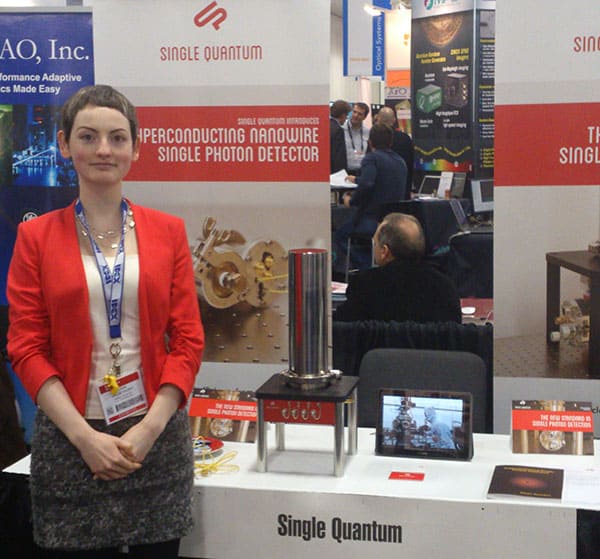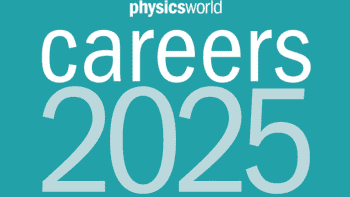Doing science involves complex experiments with uncertain outcomes, and starting a company based on innovations from the lab is no different. Floor van de Pavert shares some of the lessons she learned from co-founding her first spin-off company

My journey into the start-up world began a little over three years ago, when I was working as a programme officer for FOM, the Dutch physics funding agency. Part of my role at FOM was to support scientists who wanted to start their own companies, and after spending time with so many enthusiastic entrepreneurs and entrepreneurial scientists, I was inspired to make the leap myself. And so in 2011 I founded a company with two physicists, Sander Dorenbos and Val Zwiller, from Leo Kouwenhoven’s group at Delft University of Technology in the Netherlands.
Dorenbos had worked on single-photon detectors during his PhD, and under Zwiller’s supervision, he had used superconducting nanowires to develop a device with unparalleled detection efficiency in the near-infrared region of the electromagnetic spectrum. The idea behind our company, Single Quantum, was to bring these single-photon detectors to market in an easy-to-use package: a “closed-cycle” cryostat that would not need to be refilled with helium.
Our product was well received in the market of scientific instruments for quantum-optics research, with a six-figure turnover in our first year. It was, however a rocky road from the start, and I learned a lot of important lessons about founding scientific start-ups – most of them, unfortunately, the hard way.
Lesson 1: Choose your team wisely
Conflicts among co-founders are one of the most common reasons why start-ups collapse. In our case, a series of team quarrels revealed that my co-founders and I had irreconcilable differences regarding the company’s strategy and management, and in the spring of 2013, I decided to leave. The lesson I learned from this is that when you start a company, you should be picky in choosing your partners. Make sure your working styles match and that you have a shared vision for the company – not only for the first few years, but also for the long term.
You should also take time at the start to discuss roles and responsibilities, time commitment and compensation. This is especially relevant for academic spin-offs, since professors with “day jobs” and students with academic commitments are unable to put in 100% of their time. Make a clear distinction between operational roles (i.e. “running the business”) and technical and scientific advisory roles. Don’t put a professor on your board of directors unless they have specific management experience and enough time to be involved hands-on. Taking time in the beginning to make fair and clear agreements and to check whether every co-founder is on the same page will improve your team dynamics in the long run.
Lesson 2: Secure your IP
Intellectual property (IP) is an important asset in academic spin-off companies, and university technology transfer offices (TTOs) are designed to help manage it. However, negotiating a deal with a TTO can be challenging and frustrating. A common pattern is that the TTO will assign a value to the IP based on the amount of research funding used to create it – suggesting in some way or another that the eventual revenue generated for the university should cover at least part of this funding. Do not go along with this approach. Instead, past spending should be viewed as sunk costs. The only value of the IP is in the future commercial opportunity. You need to de-couple the past from the future.
To do this, make sure to prepare well for the IP negotiations. Invest some time in understanding relevant IP concepts. Speak to people at other academic spin-offs from your university who have already gone through the process. And get a good lawyer: they’re worth the money, and they can help ensure that you are the first to put a draft agreement on the table. Once you’ve done that, the basic terms of the discussion will be defined, and you can work from there to a contract that is acceptable to all parties. Don’t rely on the legal information the TTO employees give you – remember, it’s not always the best law students who take jobs at a university TTO.
The most important thing to remember about IP, though, is that there’s no value in it whatsoever if no-one is willing to put in the hard, high-risk work of building a company around it.
Lesson 3: Get out of the building
A common pattern in tech-heavy start-ups is for engineers to spend months or even years working on a product without getting any feedback and guidance from customers. Then, when the product is finally launched, it turns out that a lot of effort was spent building something that nobody wants to buy. To avoid this, don’t assume you know what your customers want. Test your assumptions over and over again by getting out of the building and interacting with them. As the successful Silicon Valley serial entrepreneur Steve Blank put it, “There are no facts inside your building. So get out.”
Don’t assume you know what your customers want; test your assumptions over and over again
When you talk to your customers, ask about the problem your product is supposed to fix. Why is it a problem for them? How are they trying to solve the problem now?
Don’t get too attached to your initial ideas about how your product is going to make money. Be flexible and change your business model if necessary. Rarely do innovations emerge from a science lab market-ready and poised for success.
At Single Quantum, we had no choice but to launch our product right away, because when we founded the company we knew there was a Japanese research group that couldn’t wait to buy a system. Having a customer so early on was great, but it also gave us the (wrong) impression that we were “done” when it came to understanding our customers. In fact, our customers had many things to consider when deciding to buy or not buy our product, and I didn’t learn about these until much later, when I started talking to them at conferences and trade shows. The deep understanding of your customers needed to build a great product that people want to buy will not be found inside your building. So keep getting out.
Lesson 4: No product sells itself
Scientists and engineers generally have a hard time with sales. The idea of having to convince someone to buy our product seems awkward or even distasteful to us. Often we fall into the trap of believing that our product’s amazing technical specifications alone will win the game: “Our product is so good it sells itself!” In reality, regardless of how good your product is, getting paying customers requires putting effort into sales.
If I’m honest, when we started Single Quantum, we fell into the “our product will sell itself” trap. As a result, five months after starting the company we still had only one sale: the initial one to the Japanese group. True, we had also received 20-odd requests for quotations, and I had taken the time to make all of them a nice offer by e-mail. But I didn’t hear back from a single one.

Around this time I remember having a conversation with a senior entrepreneur during a networking reception. He had a lot of sales experience, so I explained the situation to him and asked, “What am I doing wrong?” He replied without hesitating, “You should stop sending out quotations right away.” “But they’re asking for one!” I replied. “I don’t care. People buy from people, so just sending an e-mail is not going to get you far when it comes to sales. Politely refuse to send them anything until after speaking to them, preferably in person. Drop everything and get on the phone to make appointments with those 20 people.”
At this moment I realized it had been a little foolish of me to think that people would happily fork over 7100,000 (or thereabouts) of their hard-earned research money after just getting an e-mail quotation and a spec sheet from a company that was only a few months old. This realization was a turning point for me. I started to educate myself and my team on sales techniques by following training programmes and working with a dedicated sales coach.
I learned that in sales it’s crucial to build a relationship with your customers, and that selling is mostly about listening and asking the right questions. I also learned that sales is a numbers game: it’s a given that a substantial percentage of your sales calls and visits will not result in an order, and you shouldn’t get discouraged by this. However, the high ratio of leads to sales means that a structured approach to handling leads – including a good customer relationship management (CRM) system – is a must.
Most of all, though, I learned you should never underestimate the time and effort that sales requires, because no product sells itself.
Lesson 5: Make marketing work for you
To support your sales work, you need to have good marketing materials. To make good marketing materials, you need to start with a well-defined idea of how you want to position your company in the market. This boils down to two questions: what kind of company do you want to be and why should customers buy your product? The answer to these questions is your brand, and this brand should be reflected in every form of communication you have with your customer.
Clearly, different products will require different brands, but for start-ups, a big part of that brand should be basic professionalism. Your marketing materials and practices need to do more than just communicate product specifications; they also need to leave no doubt in the minds of prospective customers that you are a real company, one that can be trusted to deliver on its promises.
This means that nothing in your marketing should have that “home-made” look I see too often with new spin-offs. Invest in a real designer to create a logo for you. Make sure you have a spiffy website. Get your leaflets professionally designed and printed in full colour. This does not need to be expensive; with sites such as Odesk and Elance, it’s easy to find good and cheap freelancers.
Marketing is also about the way you and your people personally interact with your customers. Set rules for phone, Skype and e-mail communication with customers and suppliers, and educate your entire team about them. Even if, in reality, you’re still a bunch of engineers and scientists beavering away in a corner of the lab, your marketing should exude competence and professionalism.
Lesson 6: Focus
As a start-up founder, your to-do list is by definition longer than everything you can do. So focus is a must. You may be asked to participate in business plan competitions, interviews, photo shoots, networking events and conference talks (especially if you’re a woman like me). Before you decide to spend time on any of these, ask yourself whether you’re doing it because it’s an ego boost, or because it contributes substantially to building your company. If it’s the former, say no and spend your time on something with higher priority instead.
As a start-up founder, your to-do list is by definition longer than everything you can do; so focus is a must
On the road again
Despite its rocky start, Single Quantum is still going strong, determined to bring its photon detector to every quantum-optics lab in the world. Its early difficulties did not scare me away from entrepreneurship, either. On the contrary, I am now applying the lessons I learned at a new tech start-up with a wonderful co-founder. The company is still very early stage, and I can’t share many details, but one thing is certain: building a company from scratch is a very interesting and rewarding experience and I am looking forward to doing it again – but this time with different, and better, mistakes.



